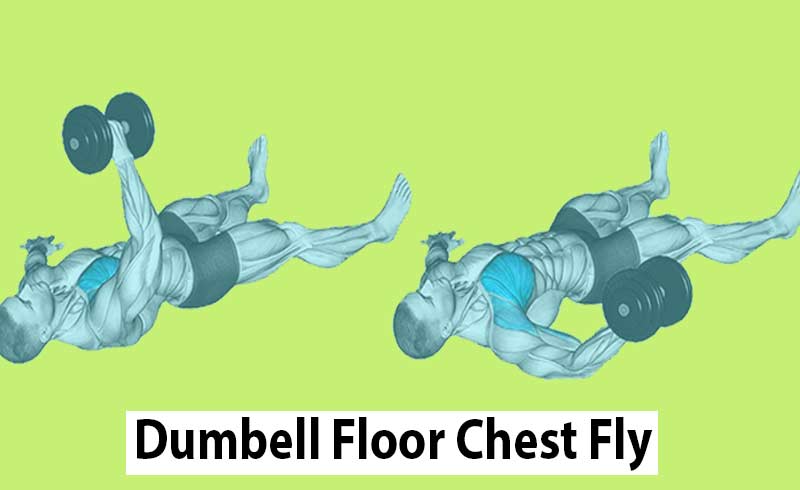The dumbbell flye exercise has faced much criticism due to its high risk-reward ratio.
Exercises like the overhead throw, often used by athletes like quarterbacks and pitchers, can put more strain on your shoulder muscles.
This makes the traditional fly exercise less appealing, as it can potentially lead to shoulder injuries.
That’s why I came up with a better exercise alternative that can deliver similar benefits, which is the dumbbell floor chest fly.
Dumbbell Floor Flys Muscles Worked
The dumbbell floor flie primarily works the chest muscles, specifically the pectoralis major, It also engages the front deltoids (shoulders) and triceps.
The triceps play a supporting role in stabilizing the movement. the delt, however, helps you push the dumbbells.
Keep in mind that proper form is key to effectively targeting these muscle groups.
How To Do Chest Floor Dumbbell Fly Properly
- Lie flat on your back on the floor using a workout mat.
- Hold a dumbbell in each hand with your palms facing each other, arms fully extended over your chest.
- Inhale deeply to prepare for the movement.
- Lower the dumbbells out to the sides in a controlled manner, maintaining a slight bend in your elbows.
- Continue the descent until you feel a gentle stretch in your chest muscles, arms aligned with your shoulders.
- Pause briefly in the stretched position, engaging your chest muscles.
- Exhale slowly as you lift the dumbbells back to the starting position.
- Focus on using your chest muscles to lift the weight.
- Complete your desired number of repetitions with proper form and control.
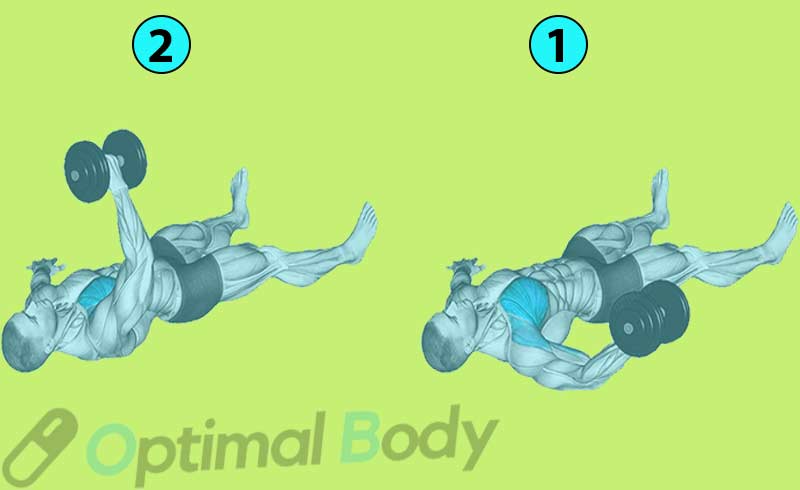
Pro Tips For Optimizing Pec Muscle Growth:
To further speed up muscle growth with the floor fly, here are some techniques that are simpler yet effective:
1. Use Heavier Weights:
Lift a weight slightly heavier than what you would typically use for the bench fly.
The floor’s safety allows you to focus on eccentric overload without worrying about injury, even if you can’t complete a rep and need to release the weights, your shoulders, and pecs remain protected.
2. Continuous Eccentrics:
Lower the weight in a controlled manner to engage eccentric muscle contraction.
If you can’t fully press the weight back up, adjust by bringing your hands closer and pressing it back up.
Repeat this process for continuous eccentrics, intensifying your chest engagement.
3. Slight Elbow Bent:
Keep your elbows bent throughout the exercise to maintain muscle tension and avoid unnecessary strain on the shoulders.
Floor Dumbbell Fly Benefits
Incorporating the Dumbbell Floor Chest Fly into your routine can yield a lot of benefits:
- Targeted Muscle Growth: This exercise isolates the chest muscles, contributing to specific growth and sculpting.
- Improved Chest Strength: By challenging your pecs, you enhance their strength and endurance.
- Ample Range of Motion: The exercise encourages flexibility in your chest muscles, reducing the risk of stiffness.
- Stabilizer Muscle Activation: The Dumbbell Floor Chest Fly also engages stabilizer muscles, enhancing overall upper body stability.
- Break from Monotony: Adding variety to your chest workouts prevents stagnation and keeps your routine exciting.
- More Safety: One of the primary issues with the traditional fly exercise is the vulnerability of the shoulders and pectoral muscles. Failing to complete a rep can lead to a compromised anterior shoulder capsule and potential pec tears. By performing dumbbell flyes on the floor, the risk of such injuries is significantly reduced.
- Eccentric Overload: Building muscle involves overloading muscles during the eccentric phase (negative phase) of an exercise. The classic advice of using lighter weights contradicts this principle. With the floor pec fly, you can safely incorporate eccentric overload, allowing for more micro-damage to muscles and facilitating muscle growth.
Common Mistakes to Avoid
To make the most of your Dumbbell Floor Fly, try to sidestep these common mistakes that most gym trainers make:
- Overarching the Back: Maintain a neutral spine to prevent undue stress on your lower back.
- Excessively Heavy Weights: Opt for a weight that allows controlled movement; heavy weights without proper form can lead to injury.
- Flaring Elbows: Keep your elbows slightly bent and avoid letting them flare outward to protect your shoulder joints.
- Rushing Through Repetitions: Focus on controlled movements and avoid any jerking or swinging actions for the sake of increasing your reps.
Best Floor Dumbbell Fly Alternatives
1. Wide Grip Bench Press:
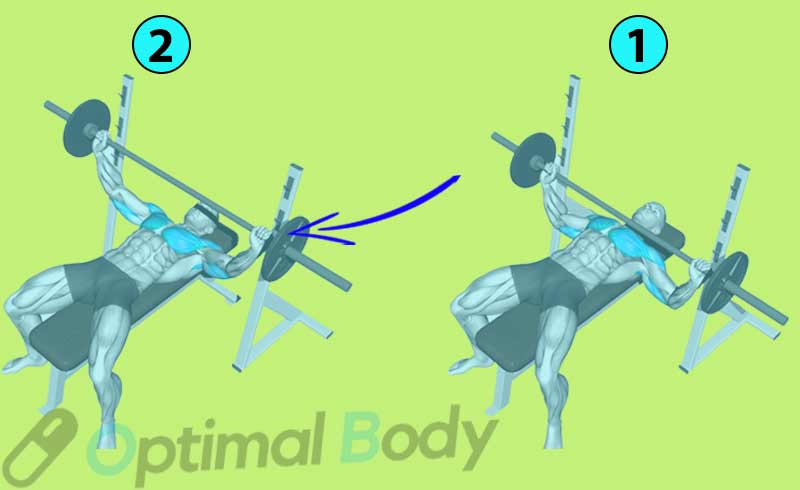
While not a direct mimic of the chest fly, the wide-grip press is an effective way to engage the outer chest muscles.
By using a wider grip on the barbell, you create a stretch similar to the one experienced during the dumbbell chest fly.
This exercise also supports overall chest development and contributes to building chest strength.
2. Banded Chest Flyes:
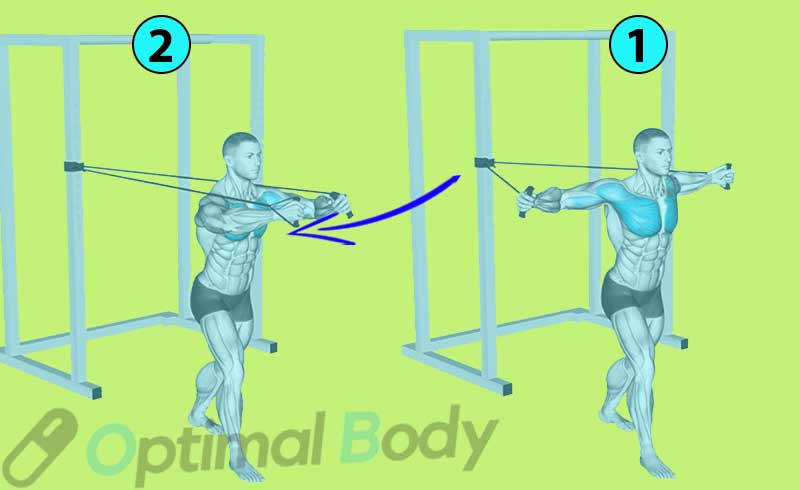
This alternative utilizes resistance bands, which are versatile tools that add continuous tension to your chest muscles throughout the movement.
The banded chest fly primarily targets the pec minor, a part of the chest often overlooked. it creates resistance as you bring your arms together, engaging your chest muscles effectively.
This exercise can be especially beneficial for individuals looking to emphasize certain areas of their chest.
3. TRX Flyes:
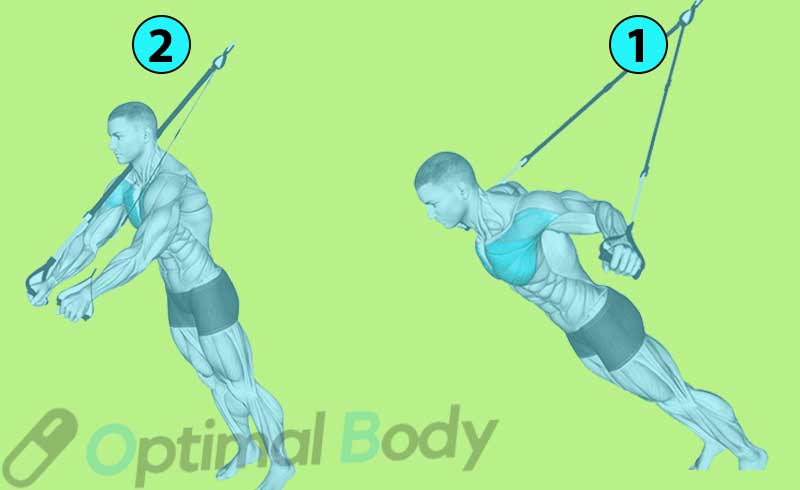
The TRX chest fly is a bodyweight exercise that combines chest engagement with core and glute activation.
Using TRX straps, you control the angle of your body, making the exercise more or less challenging.
This movement engages multiple muscle groups, making it a great option for functional strength and stability.
4. Cable Flys:
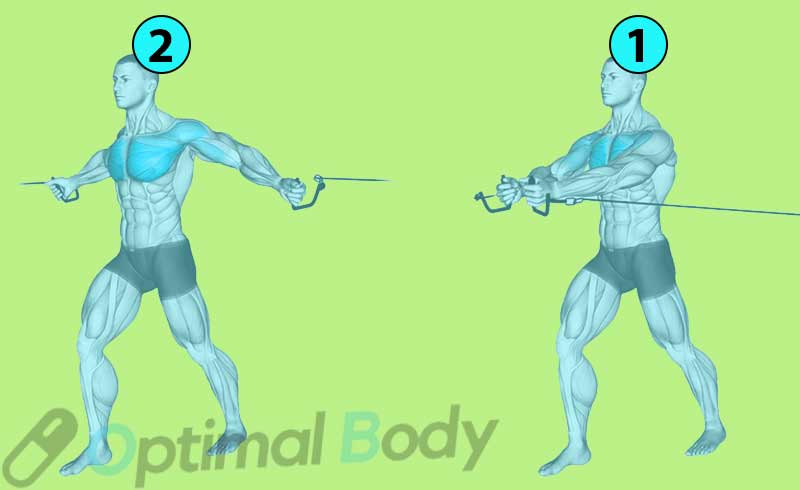
Training with a cable machine, the cable fly is known for its ability to target the chest muscles from various angles.
This exercise provides a controlled motion, allowing you to feel a strong contraction in your chest muscles without excessive strain on your shoulders.
The adjustable cable height lets you modify the range of motion, which can help you focus on specific parts of your chest.
Check Some of its alternatives
5. Front Raises for Chest and Delts:
Despite its name, this exercise primarily targets the upper chest muscles.
By lifting dumbbells in front of you, you engage the upper portion of your chest, which contributes to balanced chest development.
It’s particularly useful for those seeking a more pronounced upper chest appearance.
6. Sliding Pushup:
Using hand pads or socks on a smooth surface, the sliding pushup provides a unique challenge.
As you perform pushups with sliding hands, your chest muscles are engaged, and the sliding motion adds a dynamic element.
This exercise effectively combines chest activation with the benefits of bodyweight movement.
Frequently Asked Questions About Floor DB Fly
How frequently should I incorporate Dumbbell Floor Chest Fly into my regimen?
Integrate the Dumbbell Floor Fly into your chest workout 2-3 times per week for optimal outcomes.
Can beginners safely attempt the Dumbbell Chest Fly?
Certainly, beginners can partake in this exercise. However, start with lighter weights and focus on mastering the correct technique before progressing to heavier loads.
Are there alternatives to the Dumbbell Floor Flye?
Absolutely, you can do the traditional Dumbbell Chest Press, a solid alternative that targets chest muscles effectively.
Should I perform the Floor Fly at the start or end of my workout?
For the best results, include the Floor Chest Fly early in your chest routine when your muscles are fresh and capable of maintaining proper form.
What advanced variations can I try?
Elevate your routine by attempting the exercise on an inclined bench or incorporating resistance bands for added resistance.
Can the Chest Fly on the floor aid in reducing chest fat?
While targeted exercises strengthen muscles, spot reduction of fat isn’t feasible. To minimize fat, maintain a balanced workout regimen and a healthy diet.
References & Resources:
- Padulo, Johnny et al. “Concentric and eccentric: muscle contraction or exercise?.” Sports health vol. 5,4 (2013): 306. doi:10.1177/1941738113491386
- Reiser, Fernando & Lira, Jumes & Bonfim, Beatriz & Filho, Solival & Durante, Bruno & Cardoso, João & Miotto, Hamilton & Soares, Marcos & Bonuzzi, Giordano & Tavares, Lucas. (2017). Electromyography of Dumbbell Fly Exercise Using Different Planes and Labile Surfaces. Journal of Exercise Physiology Online. 20. 31.
- Ikeda Y, Miyatsuji K, Kawabata K, Fuchimoto T, Ito A. Analysis of trunk muscle activity in the side medicine-ball throw. J Strength Cond Res. 2009;23(8):2231-2240. doi:10.1519/JSC.0b013e3181b8676f
- Hok, P.; Opavský, J.; Labounek, R.; Kutín, M.; Šlachtová, M.; Tüdös, Z.; Kaňovský, P.; Hluštík, P. Differential Effects of Sustained Manual Pressure Stimulation According to Site of Action. Front. Neurosci. 2019, 13, 722. [Google Scholar] [CrossRef] [PubMed][Green Version]
- Cogley RM, , Archambault TA, , Fibeger JF, , Koverman MM, , Youdas JW, , Hollman JH. and Comparison of muscle activation using various hand positions during the push-up exercise. J Strength Cond Res. 2005; 19: 628– 633. http://dx.doi.org/10.1519/15094.1
- Baechle, T.R.; Earle, R.W. Essentials of Strength Training and Conditioning; Human Kinetics: Champaign, IL, USA, 2008. [Google Scholar]
- Bench Press Calculator - April 22, 2024
- Press to Handstand: Ultimate Step-by-Step Guide - April 22, 2024
- Cable Press (How To Do, Benefits, Targeted Muscles, Alternative) - April 22, 2024

